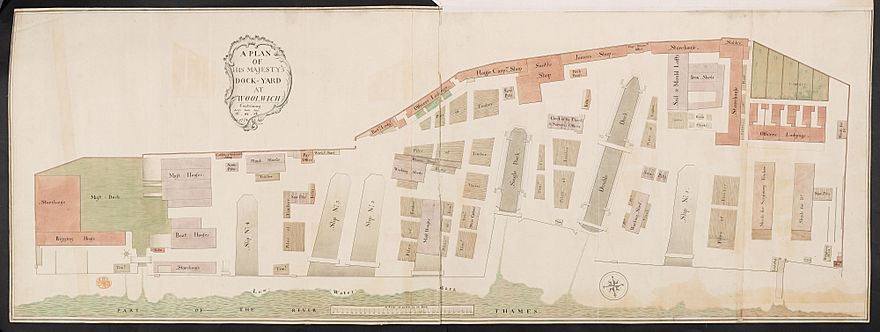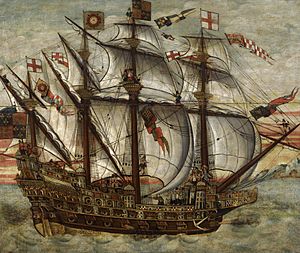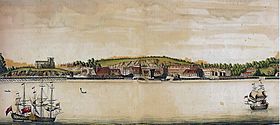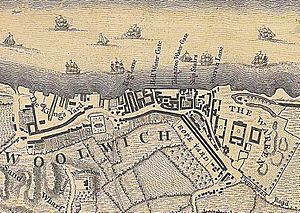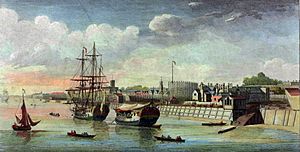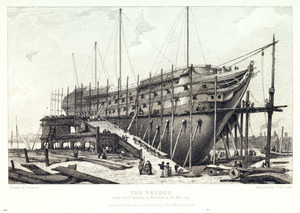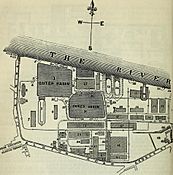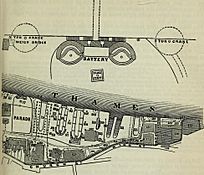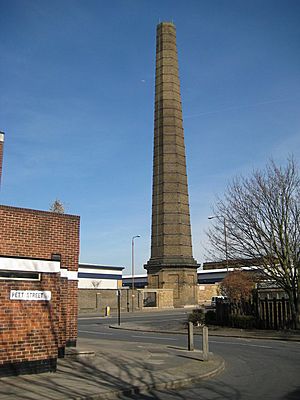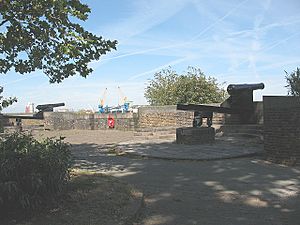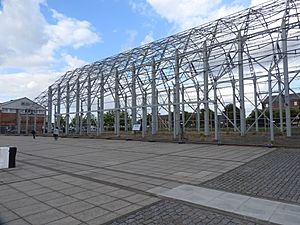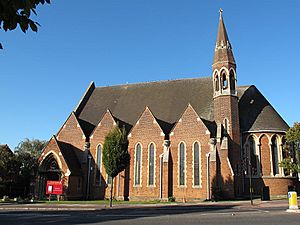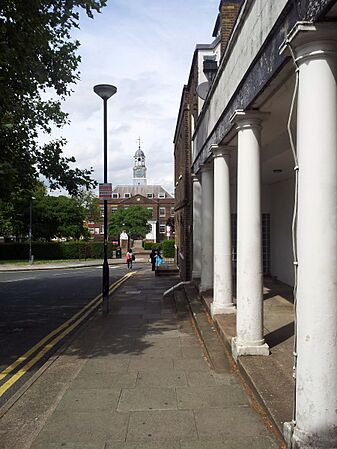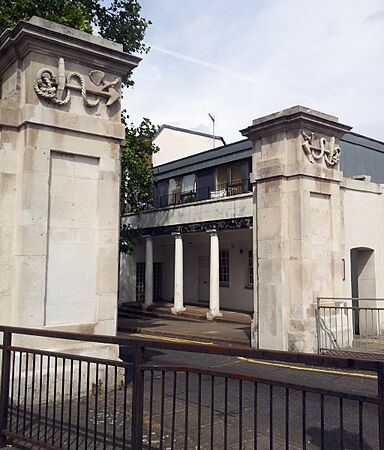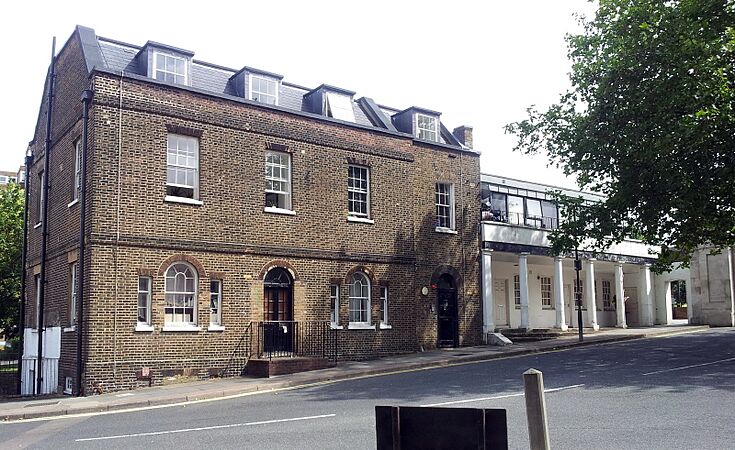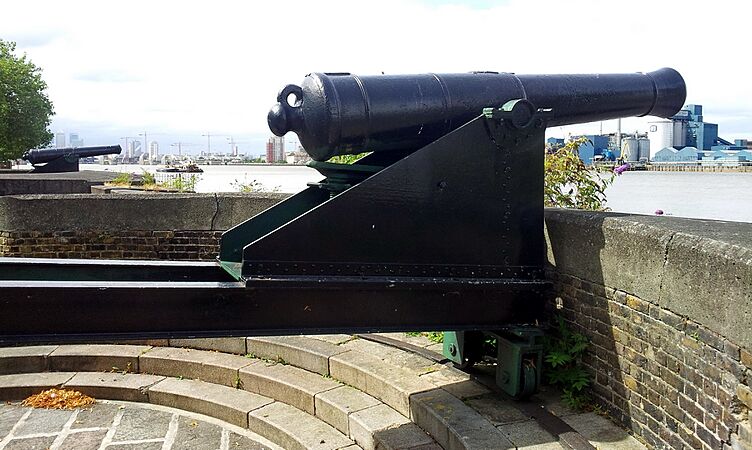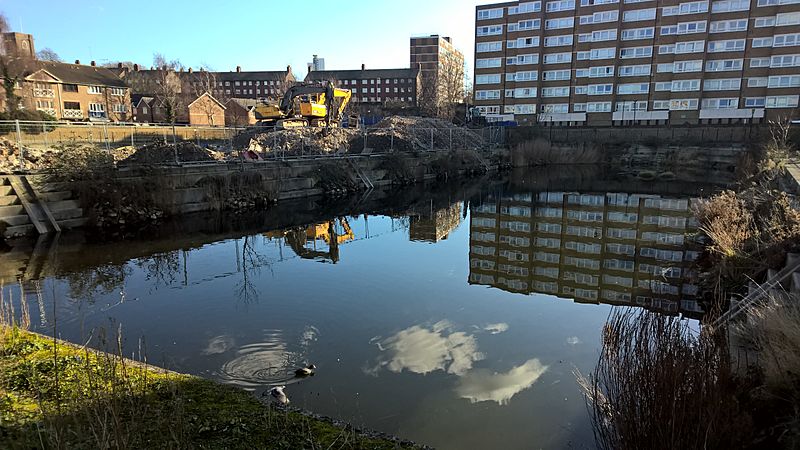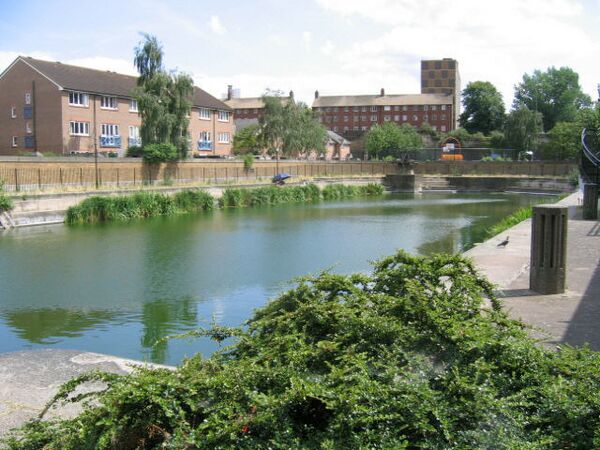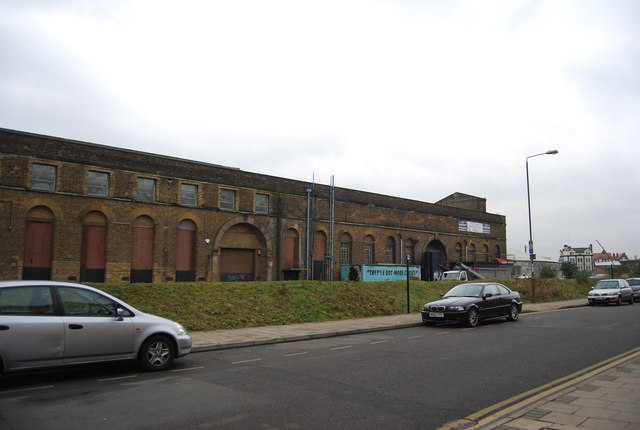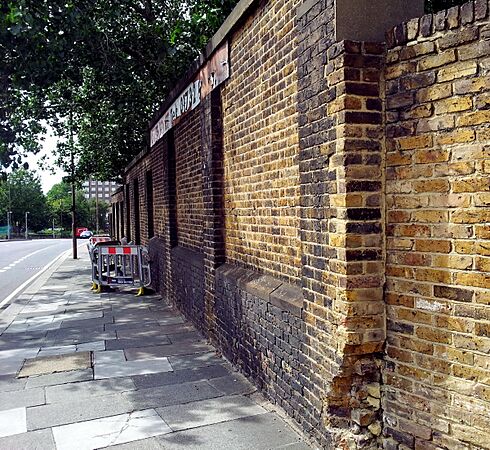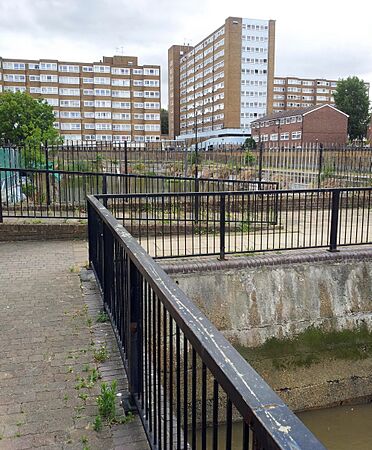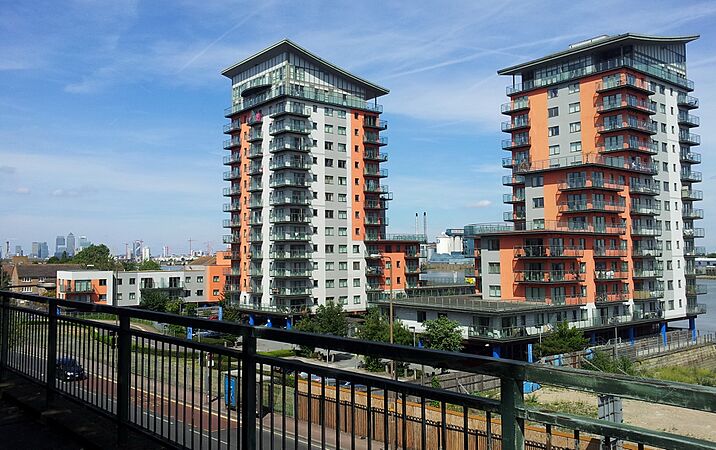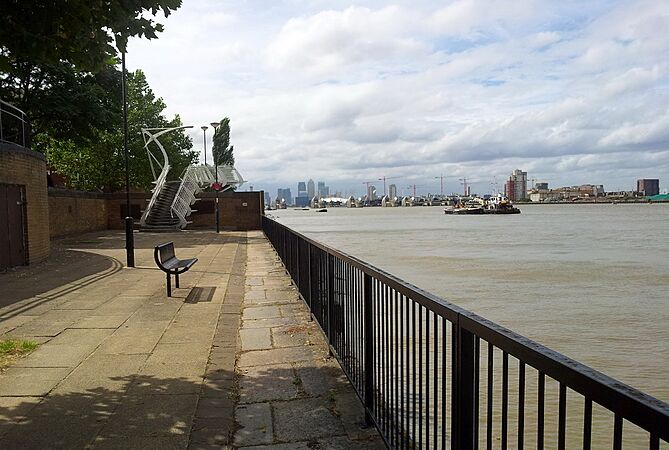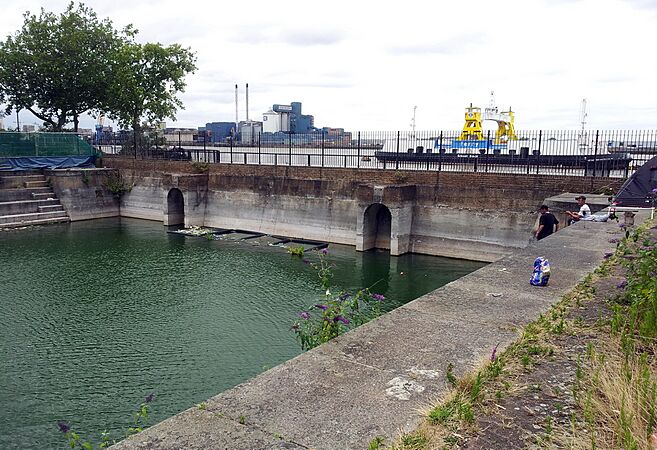Woolwich Dockyard facts for kids
Quick facts for kids HM Dockyard, Woolwich
|
|
|---|---|
| Woolwich, NW Kent | |
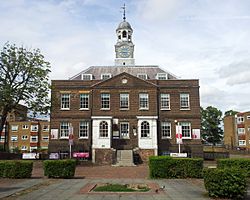
Clock House (Dockyard offices, 1783–1784), the earliest surviving building on the Woolwich Dockyard site)
|
|
| Coordinates | 51°29′40″N 0°3′22″E / 51.49444°N 0.05611°E |
| Site information | |
| Operator | Royal Navy |
| Controlled by | The Navy Board (until 1832); the Admiralty (1832–1869). |
| Other site facilities |
The Gun Wharf, The Ropeyard and The Steam Factory |
| Site history | |
| In use | 1512–1869 |
Woolwich Dockyard was a very important place where the Royal Navy built and repaired ships for hundreds of years. It was located along the River Thames in Woolwich, England. People even called it 'the Mother Dock of all England' because so many big ships were made there. In the 1600s, it was one of the most important shipyards in Europe!
For a long time, the dockyard built and fixed sailing ships. Then, in the 1830s, it became a special factory for new steam-powered ships. At its biggest, the dockyard covered 56 acres. But as ships got even larger, the Thames River became too shallow for them. So, the dockyard closed in 1869. Today, the area has homes and businesses, but you can still see parts of its old history.
History of Woolwich Dockyard
How the Dockyard Started
King Henry VIII started Woolwich Dockyard in 1512. He wanted to build his huge flagship Henri Grâce à Dieu, also known as Great Harry. This was the biggest ship of its time!
The first dockyard was a bit further east, with simple dry docks and a storehouse. Woolwich was a good choice because it was on the River Thames, close to Henry's palace at Greenwich, and had deep water. After Great Harry, other ships were built here. But by the 1520s, shipbuilding stopped for a bit, maybe because of flooding.
Around 1540, the shipbuilders moved to higher ground further west. This became the permanent home of the dockyard. It already had two dry docks, which became the main part of the new site. The Crown bought this land in 1546. Many large ships were built and repaired here in the second half of the 1500s.
Early Years and Growth
The two dry docks were rebuilt several times in the 1600s. The western dock was even made bigger to hold two ships at once. Over the years, the dockyard grew. It had slipways for building ships, places to store timber, saw pits, cranes, forges, and many storehouses. There were also homes for the important officers who worked there.
A clock house was built in 1670, which had a special room for drawing ship designs. In 1698, a grand Great Storehouse was built. Most buildings were made of wood, except for the brick mast house and Great Storehouse.
The Gun Wharf
Like other Royal Dockyards, Woolwich had a Gun Wharf. This was where guns and ammunition for ships were stored. It was located east of Bell Water Gate, where the first dockyard was founded in 1512. When the main dockyard moved, this old area was used for heavy guns and other military items. They also fixed gun carriages here.
Later, the Gun Wharf was shared with the Royal Ropeyard, which stored hemp there. The wharf was improved many times, but it still flooded often. So, in the 1650s, the military started using a new area nearby called 'The Warren' to test and store cannons. This area later became the Royal Arsenal. The Gun Wharf was no longer used for guns after 1671, but the Ropeyard continued to use it for a long time.
The Ropeyard
In the 1570s, a huge naval Ropeyard was built in Woolwich. It was one of the biggest in the world! It was too long to fit inside the main dockyard, so its long buildings stretched along what is now Beresford Street. It had a 600-foot 'cable house' and other sheds for making ropes.
The Ropeyard was rebuilt after fires in 1759 and 1813. It stayed open until 1832. After that, other Royal Dockyards started making more ropes. The Ropeyard site was sold in 1833, and its buildings were taken down in 1835.
A Time of Great Growth
Towards the end of the 1600s, the dockyard's work slowed down. But in the early 1700s, it grew again! The site doubled in size, and so did the number of workers. In the first 10 years of the 1700s, Woolwich launched more ships than any other English shipyard. Many new buildings were built or rebuilt, mostly with bricks.
New land was added to the east, where three new slips were built. A new mast pond was made, along with mast houses and boat sheds. A large rigging house was also built. Next to the Great Storehouse, a huge building for sails and ship designs was built in 1740. To the west, new houses for officers were built in the 1750s.
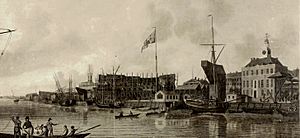
The dockyard expanded even more to the west in the 1780s, almost doubling in size again. Much of this new area was used to store timber, which was needed as the Navy's ships grew bigger. Two new mast ponds were built for very long masts (up to 120 feet!). The old pond was then used for building and storing ship's boats. A new clock house was built in the middle of the expanded yard, with offices and a new main entrance.
Shipbuilding continued strongly during the Napoleonic Wars. But the Thames River kept getting shallower. In 1802, a steam-powered bucket dredger was used to clear the river, but the silting continued. Even so, the dockyard kept growing. In 1814, a large metal-working factory was added to make anchors and other iron parts.
In the 1820s, two new covered slips (No.1 and No.2 Slips) were built, big enough for the newest ship designs. In the 1830s and 1840s, a large part of the river wall was rebuilt with brick, and the two dry docks were rebuilt with granite. A steam-powered saw-mill was also added, along with a new workshop with steam hammers.
The Steam Factory and Final Years
From 1831, Woolwich became a special place for marine steam engineering. New buildings were constructed to make and fix steam engines. These included a boiler shop, foundries for different metals, and a shop for putting engines together. By 1843, all these were part of one big factory complex with a large chimney.
Two mast ponds were changed into steam basins. Ships could dock here while their engines were installed. One basin even had its own dry dock. The factory had its own gate and was run by its own Chief Engineer.
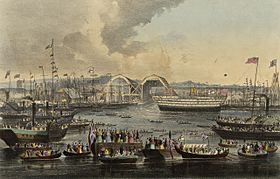
Woolwich was the main place for Navy steam engineering in the 1840s. But then, bigger steam yards were built at Portsmouth and Devonport. Woolwich's basins were no longer big enough for the new, larger ships. Older ships still came for repairs, but the steam factory's time was ending after the Crimean War.
Even so, the dockyard kept building ships and its facilities were improved in the 1850s and early 1860s. A new rolling mill and an armour plate shop were built, along with a new sail loft. But the yard couldn't keep up with the needs of the new ironclad warships. By 1865, it was clear that Woolwich Dockyard would close.
Administration of the Dockyard

From 1630 to 1688, the Master Shipwright was the most important person at the dockyard. After that, a resident commissioner from the Navy Board took charge, and the Master Shipwright became their deputy. The Commissioner of the Navy at Woolwich Dockyard also had a say in the Navy Board in London. In 1832, the commissioner's job was replaced by a captain-superintendent.
Notable Ships Built Here

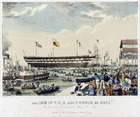
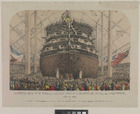
Many famous ships were built at Woolwich Dockyard, including:
- 1512–14 – Henri Grâce à Dieu (Great Harry); King Henry VIII's main ship.
- 1557–59 – Elizabeth Jonas; fought against the Spanish Armada in 1588.
- 1610 – HMS Prince Royal
- 1637 – HMS Sovereign of the Seas; a huge warship ordered by King Charles I.
- 1751 – HMS Dolphin; sailed around the world twice.
- 1756 – HMS Royal George; a large warship that sank in 1782, causing about 800 lives to be lost.
- 1809 – HMS Macedonian; a frigate captured by the US during the War of 1812.
- 1820 – HMS Beagle; the ship used by naturalist Charles Darwin on his famous voyage.
- 1852 – HMS Agamemnon; the first British battleship designed with steam power from the start.
- 1868 – HMS Repulse; the last wooden battleship built for the Royal Navy.
Closure and What Happened Next
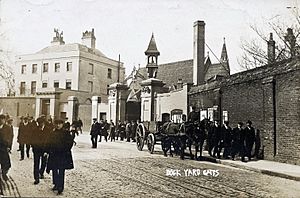
Woolwich Dockyard officially closed in 1869. However, most of the land was kept by the War Office (the government department in charge of the army). They continued to call it 'Woolwich Dockyard' for another 100 years!
How the Army Used the Site
After the Navy left, the land was used by the Army for storage. They stored general items like barrack supplies and harnesses here, while weapons stayed at the nearby Royal Arsenal. Many new warehouses were built, and old buildings were changed into storage spaces. There were also workshops to make harnesses and other items.
A railway system, with both narrow and standard tracks, served the area. The standard tracks connected to the North Kent Line through a tunnel under Woolwich Church Street. This tunnel is still there for people to walk through today. The dockyard church was used by soldiers living nearby.
From 1878, part of the Dockyard was used to store food and supplies for soldiers serving overseas. During the Sudan Campaign, a very large store for animal feed was built. In 1889, a special office was set up here to check the quality of Royal Engineer equipment. This office stayed in the Dockyard for many years.
During the First World War, the dockyard was still used as an Army supply depot. It also had the country's largest Army Pay Office and other important military offices.
When the Second World War started, many stores were moved out of Woolwich Dockyard to protect them from air attacks. Later, military activity returned. From 1942, it became a central repair depot for the Royal Army Ordnance Corps, and the Royal Army Service Corps set up its main boat stores there.
Military Leaves the Site
In 1926, the western part of the site was sold to a company called the Royal Arsenal Co-operative Society. They still use some of the buildings today. The older, eastern part of the site stayed with the Ministry of Defence until the Royal Arsenal closed in the 1960s. The last military units left in 1966.
After that, the older part of the dockyard was turned into a housing estate in the early 1970s. In the 1980s and 90s, the Thames Path was extended through the area. Two tall apartment buildings were built at Mast Quay around 2005, and even taller ones are planned. These new buildings have changed the historic look of the area.
What's Left Today
On Woolwich Church Street, you can still see a guard house and police office from the late 1700s, near the old dockyard gates. The old dockyard administration building is now the Clockhouse Community Centre. It was built between 1778 and 1784.
Closer to the river, some old, closed-off docks have been saved and partly rebuilt. They remind us of the area's shipbuilding past. Two shipbuilding slips also remain, on either side of the new Mast Quay apartments. Two old guns are mounted on the riverside where a Royal Marines gun battery used to be.
Other old industrial buildings include parts of the factory wall along Woolwich Church Street and parts of the Steam Factory with its tall chimney. The original factory building from 1838 still stands on Ruston Road, though it's shorter than it used to be. It once held boiler shops, a foundry, and shops for building steam engines.
A smithery (metalworking shop) from 1847, which had 48 furnaces and 5 Nasmyth steam hammers, stands nearby. A smaller building to the west, which was a coppersmiths' and brass founders' shop, can also still be seen. The building across from the police house at the West Gate was built in 1848–49 as the Woolwich Dockyard School for Apprentices. This school taught steam engineering to apprentices from all royal dockyards.
Less than half a mile south of the site, there is a railway station called Woolwich Dockyard.
Buildings Moved to New Homes
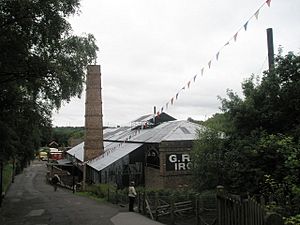
An iron-framed building from 1814, designed by John Rennie the Elder, was moved from Woolwich in the 1970s. It was rebuilt at Ironbridge and is now part of the Blists Hill foundry exhibit. In the dockyard, it was Rennie's anchor forge, famous for being the first industrial use of steam power in a naval site.
Several metal roofs that covered shipbuilding slips at Woolwich in the 1840s and 1850s were taken apart after the dockyard closed. They were then rebuilt at Chatham to house different factories:
- One, built in 1844–45, is one of the oldest surviving examples of a wide metal frame structure. It was moved to Chatham in 1880 and became a machine shop.
- Another, built in 1846–47, was also moved to Chatham in 1876 and became the main boiler shop for the steam factory there. After being empty for many years, it was restored in 2002–03 and is now the main mall of Chatham's Dockside Outlet shopping centre.
- A third slip cover, built in 1856–58, was also moved to Chatham in the 1870s. It became the main Engineering Factory of the expanded dockyard, but it was later taken down around 1990.
The Dockyard Church, designed by George Gilbert Scott and built between 1856 and 1858, used to stand just inside the main gate. It could seat 1,200 people and was for the officers, workers, and Royal Marines. After being unused for a while, it was taken apart and rebuilt in 1932 in Eltham, where it is still used as St Barnabas's Church today.
Images for kids



